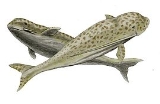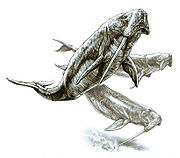
Odobenocetops
Encyclopedia
Odobenocetops was a small whale
from the Pliocene
. It had two tusks, and, in some fossils, one tusk was longer than the other.
superfamily
, more closely related to narwhal
s than dolphins, with tusks projecting towards the rear of its body. It measured about 2.1 m and weighted between 150 and 650 kg. Its neck articulations show that it was very flexible, being able to turn its head over 90 degrees. This, coupled with its broad snout, similar to that of a walrus
, suggests that it was a bottom feeder
, searching for mollusks and sucking them out of their shells with a powerful tongue.
 Perhaps the most striking discovery was that of a male O. leptodon skull with a tusk significantly longer than the other. Being the only male O. leptodon skull known, it is not safe to say it was present in all male individuals of the species. Being too brittle, the tusk was probably held parallel to the body. It might have been used to search out food, or as a sensory organ like narwhal
Perhaps the most striking discovery was that of a male O. leptodon skull with a tusk significantly longer than the other. Being the only male O. leptodon skull known, it is not safe to say it was present in all male individuals of the species. Being too brittle, the tusk was probably held parallel to the body. It might have been used to search out food, or as a sensory organ like narwhal
tusks. Even though they are closely related to these primitive whales, the tusks were gained by convergent evolution
. The abstract of an influential article on an Odobenocetops species from the journal Nature helps to explain why this is so:
O. leptodon and O. peruvianus were extremely similar but, if the single O. leptodon is not a sport and is representative of its type, O. leptodon probably had a small melon and, therefore, echolocation ability, but had reduced (or no) binocular vision, (Muizon, et al.)
special Sea Monsters. They were shown being easy prey for the massive prehistoric shark
C. megalodon
. It was identified that the species was Odobenocetops leptodon when Nigel Marvin was introducing it.http://www.bbc.co.uk/sn/prehistoric_life/tv_radio/wwseamonsters/deadliest_seas1_2.shtml
Whale
Whale is the common name for various marine mammals of the order Cetacea. The term whale sometimes refers to all cetaceans, but more often it excludes dolphins and porpoises, which belong to suborder Odontoceti . This suborder also includes the sperm whale, killer whale, pilot whale, and beluga...
from the Pliocene
Pliocene
The Pliocene Epoch is the period in the geologic timescale that extends from 5.332 million to 2.588 million years before present. It is the second and youngest epoch of the Neogene Period in the Cenozoic Era. The Pliocene follows the Miocene Epoch and is followed by the Pleistocene Epoch...
. It had two tusks, and, in some fossils, one tusk was longer than the other.
Description
Odobenocetops was an early member of the dolphinDolphin
Dolphins are marine mammals that are closely related to whales and porpoises. There are almost forty species of dolphin in 17 genera. They vary in size from and , up to and . They are found worldwide, mostly in the shallower seas of the continental shelves, and are carnivores, mostly eating...
superfamily
Taxonomic rank
In biological classification, rank is the level in a taxonomic hierarchy. Examples of taxonomic ranks are species, genus, family, and class. Each rank subsumes under it a number of less general categories...
, more closely related to narwhal
Narwhal
The narwhal, Monodon monoceros, is a medium-sized toothed whale that lives year-round in the Arctic. One of two living species of whale in the Monodontidae family, along with the beluga whale, the narwhal males are distinguished by a characteristic long, straight, helical tusk extending from their...
s than dolphins, with tusks projecting towards the rear of its body. It measured about 2.1 m and weighted between 150 and 650 kg. Its neck articulations show that it was very flexible, being able to turn its head over 90 degrees. This, coupled with its broad snout, similar to that of a walrus
Walrus
The walrus is a large flippered marine mammal with a discontinuous circumpolar distribution in the Arctic Ocean and sub-Arctic seas of the Northern Hemisphere. The walrus is the only living species in the Odobenidae family and Odobenus genus. It is subdivided into three subspecies: the Atlantic...
, suggests that it was a bottom feeder
Bottom feeder
Demersal fish live on or near the bottom of the sea or lakes. They occupy the sea floors and lake beds, which usually consist of mud, sand, gravel or rocks. In coastal waters they are found on or near the continental shelf, and in deep waters they are found on or near the continental slope or along...
, searching for mollusks and sucking them out of their shells with a powerful tongue.
Tusk use

Narwhal
The narwhal, Monodon monoceros, is a medium-sized toothed whale that lives year-round in the Arctic. One of two living species of whale in the Monodontidae family, along with the beluga whale, the narwhal males are distinguished by a characteristic long, straight, helical tusk extending from their...
tusks. Even though they are closely related to these primitive whales, the tusks were gained by convergent evolution
Convergent evolution
Convergent evolution describes the acquisition of the same biological trait in unrelated lineages.The wing is a classic example of convergent evolution in action. Although their last common ancestor did not have wings, both birds and bats do, and are capable of powered flight. The wings are...
. The abstract of an influential article on an Odobenocetops species from the journal Nature helps to explain why this is so:
The recent discovery in the Southern Hemisphere (15.5 °S) of a walrus-like skull of a toothed whale (odontocete) from the Pisco Formation of southern Peru presents a startling example of convergence and specialization unprecedented among cetaceans. In contrast to other toothed whales, Odobenocetops peruvianus has no elongated rostrum but has large, ventrally directed premaxillary alveolar processes housing asymmetrical tusks. The dorsally facing orbits indicate the possibility of dorsal binocular vision which could compensate for the absence of the melon, a rostral organRostral organThe rostral organ of the coelacanth is a large gel-filled cavity in the snout, with three pairs of canals to the outside.It is surrounded by an insulating layer of adipose tissue and innervated by the superficial ophthalmic nerve. Its anatomy and innervation suggest it is an electroreceptive organ...
involved in echolocation. Strong muscle scars on the anterior edge of the premaxillae suggest the presence of a powerful upper lip. It is this feature, together with the morphology of the deep vaulted palate devoid of maxillary teeth, that enables us to hypothesize a convergent feeding adaptation with the walrus which feeds mainly on thin-shelled bivalve molluscs, sucking out the foot and/or siphon and ejecting the shell. The structure of the face and basicranium indicates it was a delphinoid cetacean, probably related to the living beluga and narwhal (Monodontidae). (Muizon)
O. leptodon and O. peruvianus were extremely similar but, if the single O. leptodon is not a sport and is representative of its type, O. leptodon probably had a small melon and, therefore, echolocation ability, but had reduced (or no) binocular vision, (Muizon, et al.)
In popular culture
Odobenocetops was featured in the Walking With...Walking with Dinosaurs
Walking with Dinosaurs is a six-part documentary television miniseries that was produced by BBC, narrated by Kenneth Branagh, and first aired in the United Kingdom, in 1999. The series was subsequently aired in North America on the Discovery Channel in 2000, with Branagh's voice replaced with that...
special Sea Monsters. They were shown being easy prey for the massive prehistoric shark
Shark
Sharks are a type of fish with a full cartilaginous skeleton and a highly streamlined body. The earliest known sharks date from more than 420 million years ago....
C. megalodon
Megalodon
The megalodon and ὀδούς ) is an extinct species of shark that lived roughly from 28 to 1.5 million years ago, during the Cenozoic Era .The taxonomic assignment of C...
. It was identified that the species was Odobenocetops leptodon when Nigel Marvin was introducing it.http://www.bbc.co.uk/sn/prehistoric_life/tv_radio/wwseamonsters/deadliest_seas1_2.shtml

